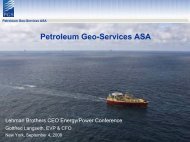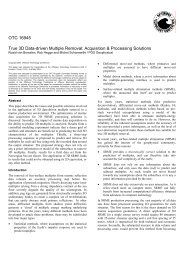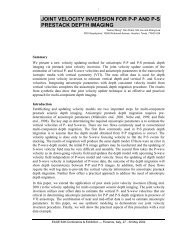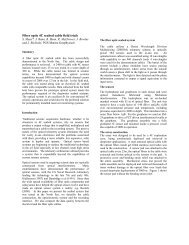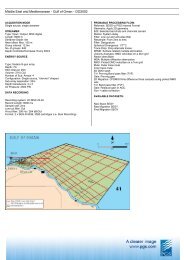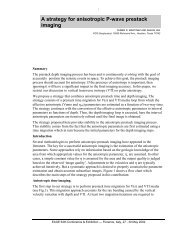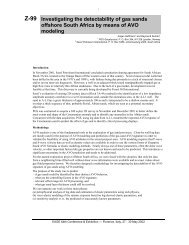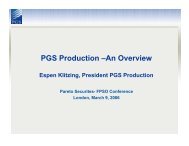Annual Report 2011 - PGS
Annual Report 2011 - PGS
Annual Report 2011 - PGS
Create successful ePaper yourself
Turn your PDF publications into a flip-book with our unique Google optimized e-Paper software.
Operations<br />
Marine Contract<br />
Efficiency and Productivity Leadership<br />
Complete Marine Contract Product Offering<br />
Expanding Marine Contract business<br />
Surveying with the<br />
highest productivity<br />
available, positions<br />
Marine Contract to<br />
deliver among the<br />
highest profit margins<br />
in the industry<br />
Seismic Data under<br />
Exclusive Client<br />
Contracts<br />
Despite healthy bidding volumes, pricing<br />
for marine contract work in <strong>2011</strong> remained<br />
depressed throughout the year as a result of<br />
excess industry supply.<br />
The Marine Contract business unit acquires<br />
seismic data under exclusive contracts with its<br />
customers, who retain ownership of the survey<br />
data. In <strong>2011</strong>, <strong>PGS</strong> used 72 percent of active<br />
vessel capacity for marine contract seismic<br />
work. Creation of growth opportunities for <strong>PGS</strong><br />
through commercialization of new technology<br />
and business ideas is also a function of the<br />
Marine Contract business unit. Key new<br />
ventures are <strong>PGS</strong>’ towed EM solution and<br />
OptoSeis ® , a fiber-optic seismic monitoring<br />
system that is permanently installed at a<br />
producing field.<br />
Aiming High<br />
<strong>PGS</strong>’ vision is to be the industry’s best<br />
geophysical supplier; the Company’s mission<br />
is providing reliable, on time and on budget<br />
delivery of seismic data, with a global presence<br />
to meet customer needs using leading-edge<br />
technology.<br />
<strong>PGS</strong> has gained considerable respect in the<br />
international marine contract market as a result<br />
of the Company’s distinctive focus on specially<br />
designed seismic vessels that can tow the<br />
largest streamer spreads in the industry. The<br />
ability to tow large, dense streamer spreads, as<br />
well as rapid streamer deployment and retrieval<br />
systems, are critical factors that secure<br />
seismic acquisition efficiency and reliable on<br />
time delivery of seismic data. <strong>PGS</strong>’ Ramform<br />
vessels are uniquely designed to excel at<br />
seismic tasks. Measured in terms of cost per<br />
streamer per day, no other fleet in the industry<br />
delivers better productivity than the <strong>PGS</strong><br />
fleet. Surveying with the highest productivity<br />
available, positions Marine Contract to deliver<br />
among the highest profit margins in the<br />
industry.<br />
HD3D<br />
High Density 3D (HD3D) seismic is a premium<br />
seismic data product that addresses a broad<br />
range of challenges in exploration, reservoir<br />
description and reservoir monitoring (4D).<br />
There are several ways to acquire HD3D. The<br />
most common HD3D technique is to use a<br />
narrower streamer separation than the 100<br />
meters typically used for exploration seismic.<br />
Acquisition techniques such as Wide-Azimuth,<br />
Multi-Azimuth and repetitive 4D surveying are<br />
integral to <strong>PGS</strong>’ HD3D product range.<br />
Measured in vessel months, HD3D activity<br />
accounted for approximately 35 percent of the<br />
total seismic market in <strong>2011</strong>. Approximately 55<br />
percent of <strong>PGS</strong>’ Ramform vessel months were<br />
dedicated to this segment, while competition<br />
generally allocates around 30 percent. Demand<br />
is more stable for HD3D, especially 4D<br />
surveying, than the demand for conventional<br />
3D seismic. The cost effective high-end<br />
Ramform fleet is optimally suited to perform<br />
HD3D surveys. <strong>PGS</strong> will continue to invest in<br />
additional HD3D capabilities, new technologies<br />
and efficiency enhancements.<br />
New Ventures<br />
While seismic data yields an image of the<br />
subsurface geology’s structure, EM data<br />
16 <strong>PGS</strong> <strong>Annual</strong> <strong>Report</strong> <strong>2011</strong>




